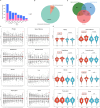An mRNA expression atlas for the duck with public RNA-seq datasets
- PMID: 40102741
- PMCID: PMC11916966
- DOI: 10.1186/s12864-025-11385-4
An mRNA expression atlas for the duck with public RNA-seq datasets
Abstract
Background: Ducks are globally important poultry species and a major source of farm animal products, including meat, eggs, and feathers. A thorough understanding of the functional genomic and transcriptomic sequences is crucial for improving production efficiency.
Result: This study constructed the largest duck mRNA expression atlas among all waterfowl species to date. The atlas encompasses 1,257 tissue samples across 30 tissue types, representing all major organ systems. Using advanced clustering analysis, we established co-expression network clusters to describe the transcriptional features in the duck mRNA expression atlas and, when feasible, assign these features to unique tissue types or pathways. Additionally, we identified 27 low-variance, highly expressed housekeeping genes suitable for gene expression experiments. Furthermore, in-depth analysis revealed potential sex-biased gene expression patterns within tissues and specific gene expression profiles in meat-type and egg-type ducks, providing valuable resources to understand the genetic basis of sex differences and particular phenotypes. This research elucidates the biological processes affecting duck productivity.
Conclusion: This study presents the most extensive gene expression atlas for any waterfowl species to date. These findings are of significant value for advancing duck biological research and industrial applications.
Keywords: Co-expression network; Differentially expressed genes; Duck; Expression atlas; Housekeeping genes; RNA-seq.
© 2025. The Author(s).
Conflict of interest statement
Declarations. Ethics approval and consent to participate: All methods were carried out following relevant guidelines and regulations. All duck work was conducted following a protocol approved by Sichuan Agricultural University China’s animal ethics and welfare committee (AEWC). Consent for publication: Not applicable. Competing interests: The authors declare no competing interests.
Figures






Similar articles
-
Skeletal Muscle Transcriptome Analysis of Hanzhong Ma Duck at Different Growth Stages Using RNA-Seq.Biomolecules. 2021 Feb 19;11(2):315. doi: 10.3390/biom11020315. Biomolecules. 2021. PMID: 33669581 Free PMC article.
-
A joint analysis strategy reveals genetic changes associated with artificial selection between egg-type and meat-type ducks.Anim Genet. 2020 Dec;51(6):890-898. doi: 10.1111/age.13014. Epub 2020 Oct 15. Anim Genet. 2020. PMID: 33058234
-
Whole-Transcriptome RNA Sequencing Uncovers the Global Expression Changes and RNA Regulatory Networks in Duck Embryonic Myogenesis.Int J Mol Sci. 2023 Nov 16;24(22):16387. doi: 10.3390/ijms242216387. Int J Mol Sci. 2023. PMID: 38003577 Free PMC article.
-
Characterization and comparative transcriptomic analysis of skeletal muscle in female Pekin duck and Hanzhong Ma duck during different growth stages using RNA-seq.Poult Sci. 2023 Dec;102(12):103122. doi: 10.1016/j.psj.2023.103122. Epub 2023 Sep 18. Poult Sci. 2023. PMID: 37832186 Free PMC article.
-
The study of candidate genes in the improvement of egg production in ducks - a review.Poult Sci. 2022 Jul;101(7):101850. doi: 10.1016/j.psj.2022.101850. Epub 2022 Mar 11. Poult Sci. 2022. PMID: 35544958 Free PMC article. Review.
References
-
- Li J. Analysis of the evolution of sex chromosomes in Pekin Duck and monotremes. Zhejiang University; 2020.
-
- Wickramasinghe S, Cánovas A, Rincón G, Medrano JF. RNA-sequencing: a tool to explore new frontiers in animal genetics. Livest Sci. 2014;166:206–16.
MeSH terms
Substances
Grants and funding
LinkOut - more resources
Full Text Sources

